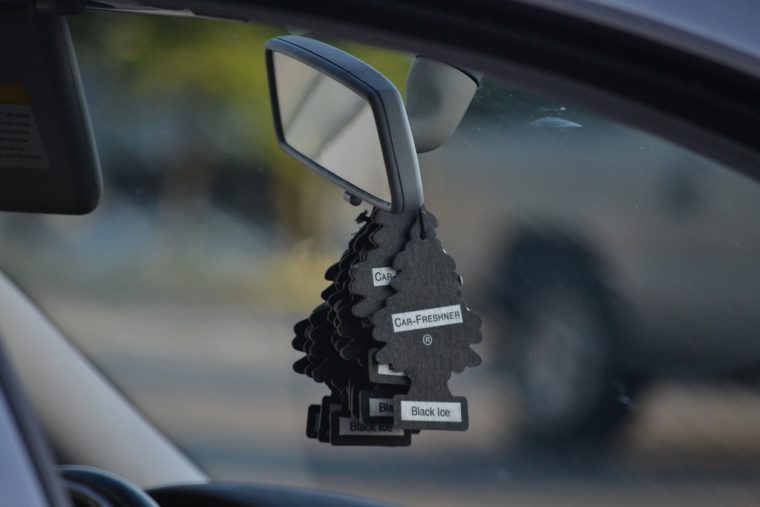A Look Back at Little Trees Air Fresheners
Investigating the history of the ubiquitous air freshener

Photo: Tony Alter via CC
With 60 years of history in the rearview mirror, Little Trees air fresheners have risen to fame as an iconic car accessory and cultural touchstone. But where did they come from? Who designed them? And why should a pine tree, of all things, be the symbol of a fresh-smelling car?
Freshen up your car inside and out: Car Cleaning Tips for a Like-New Car for the New Year
Why the pine tree?
Back in 1952, a Watertown, New York, milkman complained about the sour stink of spilled milk permeating his truck. Fortunately, his friend Julius Samann was the right guy to solve the problem. Samann, a German-Jewish chemist, had fled to Canada to escape persecution in his home country. While in Canada, he spent five years studying the aromatic compounds in pine needles, seeking a way to transport and disseminate their essential oils. Ultimately, he ended up using a type of specialized blotting paper that was perfect for retaining long-lasting scents.
Although Samann was fond of pine trees, the original 1954 patent featured something more risqué — a paper cutout of a busty pinup girl. Ultimately, the tree was chosen for practical reasons. Its conical shape allowed consumers to peel back the wrapper one branch at a time, extending the air freshener’s life.
Branching out
By hitting the market just as cars became a household necessity, Samann’s Little Trees grew quickly. Consumers craved a quick fix for stale upholstery sullied by tobacco smoke, spilled lunches, and other grime. The Little Trees air freshener provided a quick, affordable fix with scents like Royal Pine, Spice, and Bouquet. Nowadays, the company offers around 60 scents, ranging from the cologne-like Black Ice to fun, light scents like Cotton Candy and Sunberry Cooler. The air fresheners have sold billions worldwide, even adopting names like Wunder-Baum and Arbre Magique for local markets.
Cultural impact of Little Trees
From Samann’s hometown of Uffenheim to Rio de Janeiro, you can find a Little Tree hanging on someone’s rearview mirror, so it’s no surprise that they’ve appeared in popular culture. In their 1986 song, “Slow Ride,” the Beastie Boys’ Mark D bragged, “I got trees on my mirror so my car won’t smell,” while Tracey Walter’s character in “Repo Man” points to the familiar air freshener and remarked, “You’ll find one in every car, kid.” In Norway, Sweden, and Finland, the Little Trees are an emblem of the hot rod-loving Raggare subculture.
They’ve even branched out to the art world. In 2009, British artist Jack Williams created an installation piece entitled “Forest,” featuring hundreds of Royal Pine-scented Little Trees hanging from a ceiling. When asked about his inspiration, Williams said that the design and scent evoked the feeling of being on a journey.
The classic air fresheners are so ubiquitous that Little Trees’ parent company, CAR-FRESHENER Corp., fears that the brand will become genericized, similar to how Jell-O and Band-Aid have become shorthand names for gelatin desserts and bandages, respectively. As a result, CAR-FRESHENER is fiercely protective of its tree-shaped design. Some companies, including Glade and Bob Ross Inc., have mimicked the brand and landed themselves in hot water.
Maintenance is key: 10 Tips to Make Your Used Car Last Longer
Although air freshener technology has marched on and the company has grown by leaps and bounds, it’s still family-owned, and each Little Tree is manufactured in Watertown, New York, or DeWitt, Iowa. To this day, Samann’s Little Trees continue to freshen up car interiors across the globe, adding a pop of color and charm wherever they hang.
Sources: The New York Times, Little Trees
Kimiko Kidd is a native Daytonian. She graduated from Wright State University with degrees in environmental science and sociology. She loves her trusty old Honda Civic, but dreams of owning a 1974 Ford Falcon XB with a custom paint job and a vintage Kawasaki Z1000. In her free time, Kimiko can be found watercolor-painting, baking muffins, collecting rocks, playing old-school Nintendo games, writing her novel, sewing stuffed animals, and cosplaying as her favorite Mad Max characters. See more articles by Kimiko.

